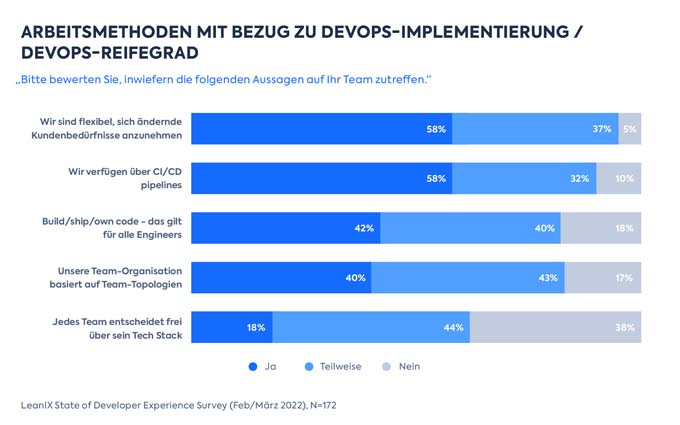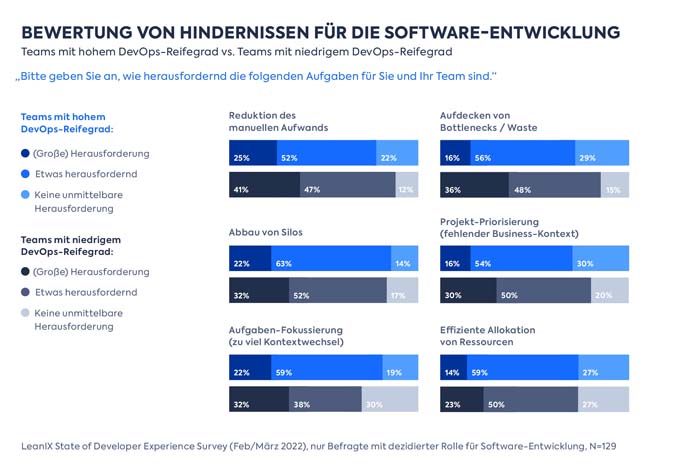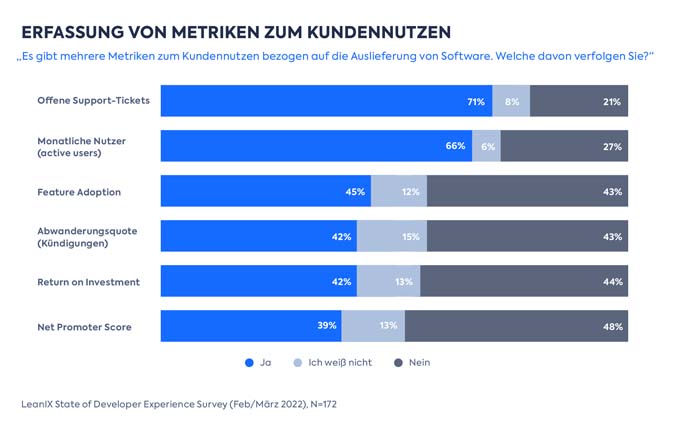Many companies lack a comprehensive DevOps culture
Companies are wasting potential in software development: Less than half have a comprehensive DevOps culture. This is shown by the State of Developer Experience Survey 2022 from LeanIX. According to this study, most respondents apply the methods characteristic of DevOps only sporadically and complain more frequently that obstacles become a challenge in their daily work. Considering the [...]

Potential of DevOps is not exploited in daily work
The study participants were asked about the use of five characteristic working methods for DevOps - with sobering results: Nearly 60 percent of the respondents state that they can react flexibly to changing customer requirements and that they have CI/CD pipelines. However, flexibility with regard to the customer and the ability to execute and test changes to the code automatically via CI/CD pipelines is central to DevOps initiatives. It is therefore notable that for more than 40 percent of teams, this basic requirement is only partially met or not met at all. The picture is even worse when it comes to the "build-ship-own your code" principle typical of DevOps, team organization based on team topologies or the free choice of tech stack. In summary, DevOps initiatives can be expanded in international companies.
Nearly 60 percent of the respondents state that they can react flexibly to changing customer requirements and that they have CI/CD pipelines. However, flexibility with regard to the customer and the ability to execute and test changes to the code automatically via CI/CD pipelines is central to DevOps initiatives. It is therefore notable that for more than 40 percent of teams, this basic requirement is only partially met or not met at all. The picture is even worse when it comes to the "build-ship-own your code" principle typical of DevOps, team organization based on team topologies or the free choice of tech stack. In summary, DevOps initiatives can be expanded in international companies.DevOps maturity level influences perception of obstacles at work
If we look at the five working methods queried, we see that the majority of developer teams (53 percent) use only up to three of these methods. This low DevOps maturity level has an influence on the assessment of obstacles in daily work. Respondents from such teams consistently rate these as a greater challenge: Reducing manual effort due to lack of automation - this is at the top of the list of obstacles described as a "major challenge" for all respondents. However, teams with a lower DevOps maturity level perceive this significantly more strongly, at 41 percent versus 25 percent. Whether breaking down silos or the difficulty of focusing on one's tasks due to frequent changes in context, whether uncovering bottlenecks, the challenge of prioritizing projects or allocating resources efficiently: in theory, agile ways of working lead to the elimination or significant reduction of these obstacles. The fact that the majority of respondents describe these issues as challenging is another indication that DevOps teams are still on a journey. This is where those responsible can start to further improve and accelerate software development in the company.
Reducing manual effort due to lack of automation - this is at the top of the list of obstacles described as a "major challenge" for all respondents. However, teams with a lower DevOps maturity level perceive this significantly more strongly, at 41 percent versus 25 percent. Whether breaking down silos or the difficulty of focusing on one's tasks due to frequent changes in context, whether uncovering bottlenecks, the challenge of prioritizing projects or allocating resources efficiently: in theory, agile ways of working lead to the elimination or significant reduction of these obstacles. The fact that the majority of respondents describe these issues as challenging is another indication that DevOps teams are still on a journey. This is where those responsible can start to further improve and accelerate software development in the company.There is a lack of a common language between IT and business
Erfolgreiche DevOps-Initiativen benötigen die Kollaboration mit allen Stakeholdern im Unternehmen – darauf weisen die Analysten von Gartner hin. Sie merken an, dass viele Initiativen auch deshalb scheitern, weil innerhalb des Unternehmens die damit verknüpften Erwartungen nicht klar definiert sind. Um diese Erwartungen zu steuern, sollten sich IT und Business auf gemeinsame Ziele und Metriken – und damit auf eine gemeinsame Sprache – verständigen, fordern die Experten. Genau diese gemeinsame Sprache fehlt aber in den Unternehmen: Nur 42 Prozent der Befragten in dieser Studie geben an, dass IT und Business einander verstehen. Betrachtet man, welche Metriken überhaupt erfasst und näher betrachtet werden, wird die fehlende Basis zur Verständigung offensichtlich.Little insight into customer value and software development efficiency
About 70 percent of developer teams look at two metrics in relation to the customer and their work: open support tickets and monthly active users - easily accessible metrics that hold the most potential for frustration and don't directly relate to the software delivered and its value to the customer: Ob Feature Adoption, Abwanderungsquote, Return on Investment oder Net Promoter Score als Ausdruck der Zufriedenheit: Jede dieser Kennzahlen wird von weniger als der Hälfte der Software-Entwicklungsteams betrachtet. Die meisten Teams haben also kaum Einblick in den tatsächlichen Erfolg und Kundennutzen ihrer konkreten Arbeitsleistung – und können diesen auch nicht mit dem Business teilen. Auch die Möglichkeit, die Performance der Software-Entwicklung anhand der vier anerkannten DORA-Metriken (Deployment Frequency, Failure Rate, Lead Time for Changes, Mean Time to Recovery) zu messen, wird nicht umfassend wahrgenommen. Ein Viertel der Befragten betrachtet nicht mal einen dieser Kennwerte. Dabei würde auch eine solche Erfassung der Leistungsfähigkeit zu einer gemeinsamen Sprache beitragen, die gegenseitige Wertschätzung erst möglich macht.
Ob Feature Adoption, Abwanderungsquote, Return on Investment oder Net Promoter Score als Ausdruck der Zufriedenheit: Jede dieser Kennzahlen wird von weniger als der Hälfte der Software-Entwicklungsteams betrachtet. Die meisten Teams haben also kaum Einblick in den tatsächlichen Erfolg und Kundennutzen ihrer konkreten Arbeitsleistung – und können diesen auch nicht mit dem Business teilen. Auch die Möglichkeit, die Performance der Software-Entwicklung anhand der vier anerkannten DORA-Metriken (Deployment Frequency, Failure Rate, Lead Time for Changes, Mean Time to Recovery) zu messen, wird nicht umfassend wahrgenommen. Ein Viertel der Befragten betrachtet nicht mal einen dieser Kennwerte. Dabei würde auch eine solche Erfassung der Leistungsfähigkeit zu einer gemeinsamen Sprache beitragen, die gegenseitige Wertschätzung erst möglich macht.Different data sources complicate the overview
Die notwendigen Informationen für relevante Kunden-Kennwerte oder die DORA-Metriken sind oftmals auf verschiedene Quellen verteilt. Ihre Erfassung wird häufig mit großem manuellen Aufwand – und in knapp 40 Prozent der Fälle sogar mit Excel-Tabellen – betrieben. Moderne Value Stream Management-Plattformen könnten helfen. Doch nur 20 Prozent der Befragten setzen diese bereits ein, um Datenströme automatisiert miteinander zu verknüpfen und den unmittelbaren Zusammenhang zu den Geschäftsergebnissen herzustellen.Expand agile ways of working despite predominantly positive developer experience
No comprehensive DevOps implementation, hurdles in daily work, little insight into the direct customer benefit of the developed software - despite this situation in the developer teams, the slight majority of respondents generally rate the developer experience rather positively: What sounds good at first, however, a closer look also shows that almost half of the respondents cannot decide on a positive assessment. Against the backdrop of a massive shortage of skilled IT staff and the increasing importance of software as a differentiator on the market, companies should do everything in their power to retain their software development teams.
What sounds good at first, however, a closer look also shows that almost half of the respondents cannot decide on a positive assessment. Against the backdrop of a massive shortage of skilled IT staff and the increasing importance of software as a differentiator on the market, companies should do everything in their power to retain their software development teams.This article originally appeared on m-q.ch - https://www.m-q.ch/de/vielen-unternehmen-fehlt-umfassende-devops-kultur/









